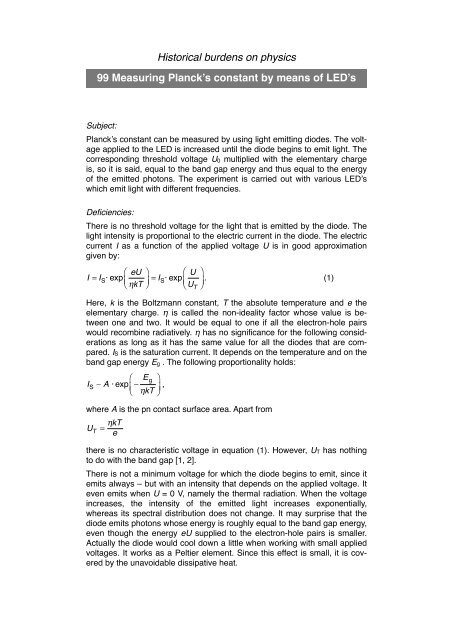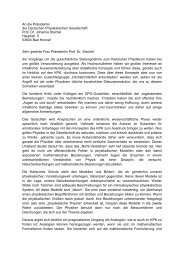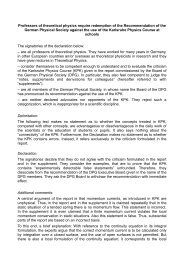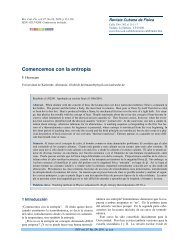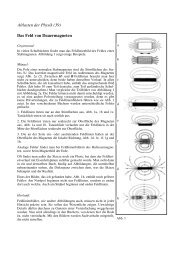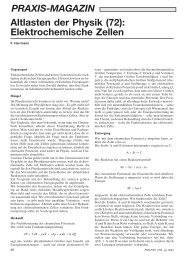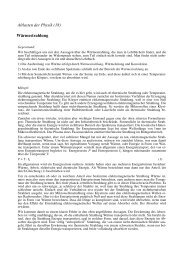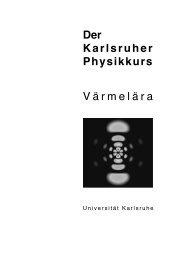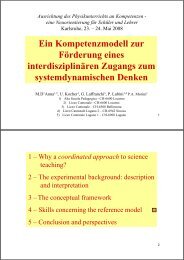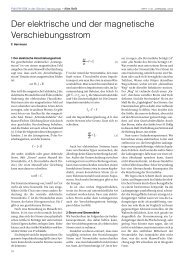99 Measuring Planck's constant by means of LED's
99 Measuring Planck's constant by means of LED's
99 Measuring Planck's constant by means of LED's
You also want an ePaper? Increase the reach of your titles
YUMPU automatically turns print PDFs into web optimized ePapers that Google loves.
Historical burdens on physics<br />
<strong>99</strong> <strong>Measuring</strong> Planck’s <strong>constant</strong> <strong>by</strong> <strong>means</strong> <strong>of</strong> LED’s<br />
Subject:<br />
Planck’s <strong>constant</strong> can be measured <strong>by</strong> using light emitting diodes. The voltage<br />
applied to the LED is increased until the diode begins to emit light. The<br />
corresponding threshold voltage U0 multiplied with the elementary charge<br />
is, so it is said, equal to the band gap energy and thus equal to the energy<br />
<strong>of</strong> the emitted photons. The experiment is carried out with various LED’s<br />
which emit light with different frequencies.<br />
Deficiencies:<br />
There is no threshold voltage for the light that is emitted <strong>by</strong> the diode. The<br />
light intensity is proportional to the electric current in the diode. The electric<br />
current I as a function <strong>of</strong> the applied voltage U is in good approximation<br />
given <strong>by</strong>:<br />
⎛<br />
I = I S· exp<br />
eU ⎞<br />
⎝<br />
⎜<br />
ηkT ⎠<br />
⎟ = I S· exp ⎛ U ⎞<br />
⎝<br />
⎜<br />
U T ⎠<br />
⎟ . ! (1)<br />
Here, k is the Boltzmann <strong>constant</strong>, T the absolute temperature and e the<br />
elementary charge. η is called the non-ideality factor whose value is between<br />
one and two. It would be equal to one if all the electron-hole pairs<br />
would recombine radiatively. η has no significance for the following considerations<br />
as long as it has the same value for all the diodes that are compared.<br />
IS is the saturation current. It depends on the temperature and on the<br />
band gap energy Eg . The following proportionality holds:<br />
⎛<br />
I S A · exp − E g ⎞<br />
⎝<br />
⎜<br />
ηkT ⎠<br />
⎟ ,<br />
where A is the pn contact surface area. Apart from<br />
U T = ηkT<br />
e<br />
there is no characteristic voltage in equation (1). However, UT has nothing<br />
to do with the band gap [1, 2].<br />
There is not a minimum voltage for which the diode begins to emit, since it<br />
emits always – but with an intensity that depends on the applied voltage. It<br />
even emits when U = 0 V, namely the thermal radiation. When the voltage<br />
increases, the intensity <strong>of</strong> the emitted light increases exponentially,<br />
whereas its spectral distribution does not change. It may surprise that the<br />
diode emits photons whose energy is roughly equal to the band gap energy,<br />
even though the energy eU supplied to the electron-hole pairs is smaller.<br />
Actually the diode would cool down a little when working with small applied<br />
voltages. It works as a Peltier element. Since this effect is small, it is covered<br />
<strong>by</strong> the unavoidable dissipative heat.
Fig. 1. Characteristic <strong>of</strong> one and the same diode represented with the current axis scaled<br />
differently. The curves have the same shape and can be made to coincide <strong>by</strong> a horizontal<br />
displacement.<br />
The procedure that is applied to get a “threshold voltage” U0 is based on an<br />
illusion. Fig. 1 shows three times the same exponential characteristic, the<br />
difference between the three representations consisting only in the choice<br />
<strong>of</strong> the axis <strong>of</strong> ordinates. Each time that the scale <strong>of</strong> the vertical current axis<br />
is changed <strong>by</strong> a factor <strong>of</strong> 100, the graph is displaced horizontally <strong>by</strong><br />
kT<br />
e · ln102 = 0,119 Volt<br />
(We have admitted that η = 1.)<br />
The “threshold voltage” which one would read from the graph changes <strong>by</strong><br />
the same amount.<br />
Origin:<br />
The experiment was introduced as a simple and inexpensive experiment for<br />
the physics lab at the high school and the university. The incorrect interpretation<br />
has a certain plausibility. Apparently, it was overlooked that a threshold<br />
voltage cannot be defined for an exponential function in principle.<br />
Disposal:<br />
Planck’s <strong>constant</strong> can be determined <strong>by</strong> <strong>means</strong> <strong>of</strong> several diodes with different<br />
band gaps, Fig. 2.
Fig. 2. Characteristics <strong>of</strong> two diodes, that emit light <strong>of</strong> different frequencies. The curves can<br />
be made to coincide <strong>by</strong> a horizontal displacement.<br />
But there is a condition: the pn contact surface area must be the same for<br />
all <strong>of</strong> the diodes. If this is the case the corresponding characteristics are<br />
distinguished only in the factor [3]<br />
⎛<br />
exp − E g ⎞<br />
⎝<br />
⎜<br />
ηkT ⎠<br />
⎟ .<br />
The band gap energy Eg is related to the average frequency <strong>of</strong> the emitted<br />
light <strong>by</strong><br />
Eg = h · f.<br />
Thus, the horizontal distance between the two curves 1 and 2 is<br />
(Eg1 – Eg2)/e.<br />
We now choose an arbitrary value I0 <strong>of</strong> the current and read the corresponding<br />
voltages Ui . We get<br />
U1 – U2 = (Eg1 – Eg2)/e<br />
or<br />
e(U1 – U2) = Eg1 – Eg2 = h(f1 – f2),<br />
and thus<br />
h = e(U 1 − U 2 )<br />
f 1 − f 2<br />
.<br />
Notice that neither<br />
eU1 = hf1<br />
nor<br />
eU2 = hf2<br />
is valid separately.
When plotting eUi over the frequency <strong>of</strong> the emitted light, one gets a<br />
straight line whose slope is equal to Planck’s <strong>constant</strong>, fig. 3.<br />
Fig. 3. For two (or more) diodes the voltage at I0 multiplied <strong>by</strong> e is plotted over the frequency<br />
<strong>of</strong> the emitted light. The slope <strong>of</strong> the straight line is equal to the Planck <strong>constant</strong>.<br />
(Sometimes tangents at the points <strong>of</strong> equal current are drawn and the voltage<br />
is read where they cut the axis <strong>of</strong> abscissas. Obviously the value is the<br />
same as when reading the voltage directly as in Fig. 2, but it may give the<br />
illusion that this section represent something like a threshold voltage.)<br />
Whether the straight line in Fig. 3 runs through the origin or not, depends<br />
only on the arbitrary choice <strong>of</strong> the value <strong>of</strong> the current I0.<br />
Instead <strong>of</strong> reading the voltage values for a given current, one <strong>of</strong>ten uses<br />
another procedure: One chooses that voltage where the diode visibly begins<br />
to emit light. Since one automatically compares the light intensity with<br />
the ambient light, a voltage value can quite reliably be determined. By this<br />
procedure a current value is defined with sufficient precision that is the<br />
same for all diodes. This explains why the procedure gives satisfying results.<br />
However, the fact that the straight line obtained in this way <strong>of</strong>ten<br />
passes through the origin is pure coincidence.<br />
[1] Herrmann, F. und Schätzle, D.: Question # 53. <strong>Measuring</strong> Planck’s <strong>constant</strong><br />
<strong>by</strong> <strong>means</strong> <strong>of</strong> an LED, Am. J. Phys. 64, 1<strong>99</strong>6, S. 1448<br />
[2] Morehouse, R.: Answer to Question # 53. <strong>Measuring</strong> Planck’s <strong>constant</strong><br />
<strong>by</strong> <strong>means</strong> <strong>of</strong> an LED, Am. J. Phys. 66, 1<strong>99</strong>8, S. 12<br />
[3] Würfel, P.: Physics <strong>of</strong> Solar Cells, Wiley-VCH, Weinheim 2009<br />
Friedrich Herrmann and Peter Würfel, Karlsruhe Institute <strong>of</strong> Technology


